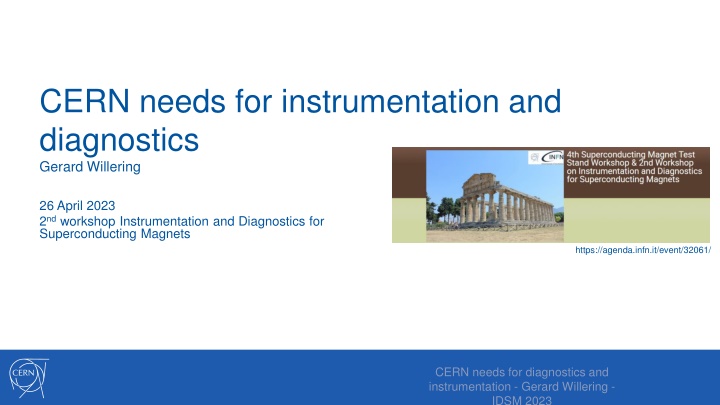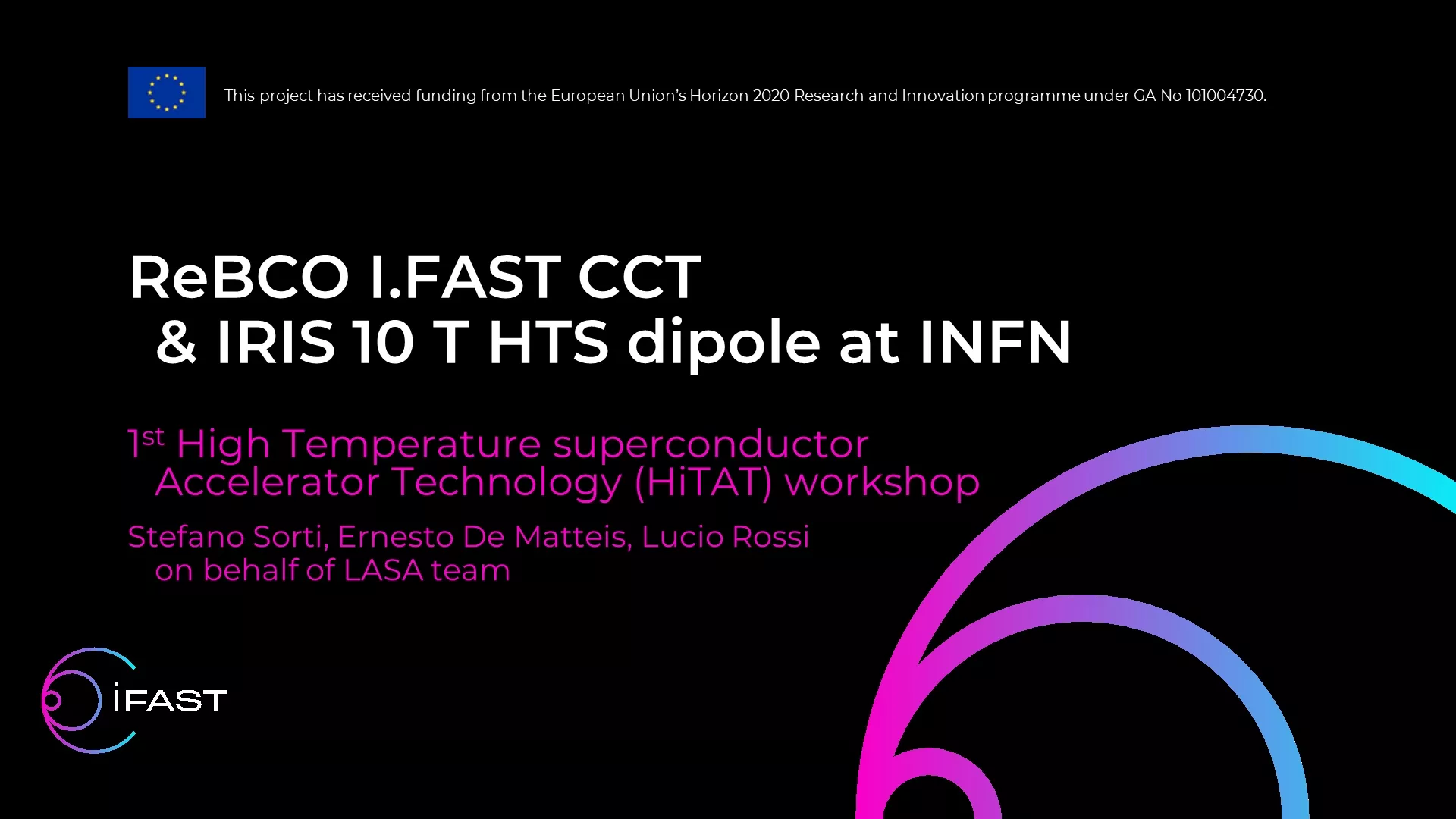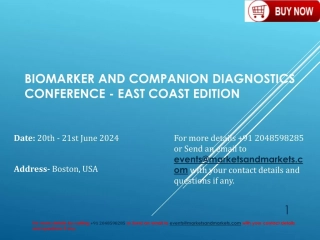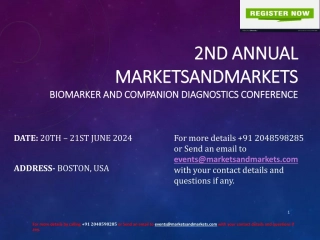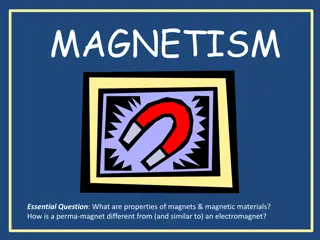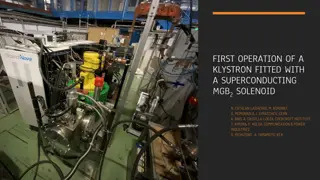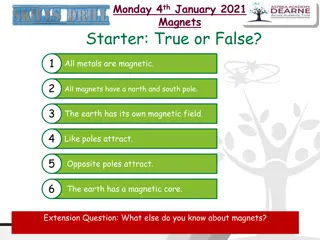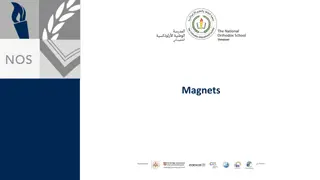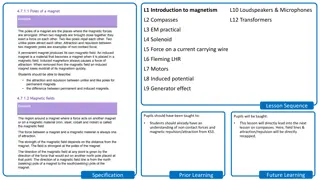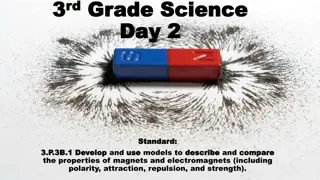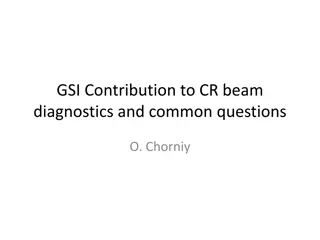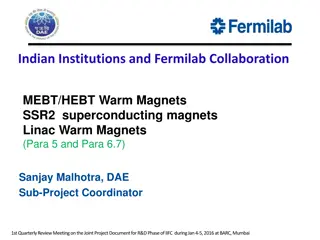Advanced Instrumentation and Diagnostics for Superconducting Magnets at CERN
Explore the crucial needs for instrumentation and diagnostics at CERN, focusing on superconducting magnets. Topics include voltage and strain measurements, vibration analysis, temperature sensing, quench detection, and magnet form factor considerations. The importance of advanced diagnostics and combining various instrumentation tools is highlighted for enhancing knowledge and interpretation methodology. Examples of quench localization and antenna sensitivity for Nb3Sn accelerator magnets are discussed, emphasizing the significance of precise quantification in understanding magnet behavior.
Download Presentation

Please find below an Image/Link to download the presentation.
The content on the website is provided AS IS for your information and personal use only. It may not be sold, licensed, or shared on other websites without obtaining consent from the author.If you encounter any issues during the download, it is possible that the publisher has removed the file from their server.
You are allowed to download the files provided on this website for personal or commercial use, subject to the condition that they are used lawfully. All files are the property of their respective owners.
The content on the website is provided AS IS for your information and personal use only. It may not be sold, licensed, or shared on other websites without obtaining consent from the author.
E N D
Presentation Transcript
CERN needs for instrumentation and diagnostics Gerard Willering 26 April 2023 2nd workshop Instrumentation and Diagnostics for Superconducting Magnets https://agenda.infn.it/event/32061/ CERN needs for diagnostics and instrumentation - Gerard Willering - IDSM 2023
It is difficult to focus, the rnage . Superconductor - NbTi - Nb3Sn - HTS Voltage measurements Strain measurements Vibration Other electical methods Temperature Pickup coils Rotating coils Hall probes Stretched wires Quench detection Flux jumps Coil strain state Conductor degradation Quench localization Magnetic field Magnet form factor - CosTheta - Common Coil - Block coil - CCT - Curved CCT - New HTS shape Cable form factor - Rutherford - Single wire - Roebel - Stack tape - CORC Advanced diagnostics - Combining all instrumentation - Develop knowledge - Develop interpretation methodology CERN needs for diagnostics and instrumentation - Gerard Willering - IDSM 2023
Starting with my last slide of the IDSM workshop in 2019 (today exactly 4 years ago) - Circumstantial evidence and qualitative description CERN needs for diagnostics and instrumentation - Gerard Willering - IDSM 2023
Starting with my last slide of the IDSM workshop in 2019 - Circumstantial evidence and qualitative description - Often used, but also often mis-used - Interpretation of magnet behavior can sometimes feel random and base on personal preferences . Quantification is key - V-I measurements quantify degradation - Quench antenna to localize quenches or motion - Vibration measurements - Strain measurements - Temperature measurements All this comes with insturmentation and diagnostic tools. CERN needs for diagnostics and instrumentation - Gerard Willering - IDSM 2023
Nb3Sn accelerator magnet quench localization CERN needs for diagnostics and instrumentation - Gerard Willering - IDSM 2023
Available quench antenna at CERN part 1 B1 sensitivity. Noise compensation by A+C, C+E and A+E computation. Available for LHC MB and 11T magnets on horizontal bench, but also for others on vertical bench. Serve both as rotating magnetic measurement shaft and as quench antenna. Horizontal bench: warm shaft, 125 cm length segments. Vertical bench: cold shaft, 25 cm length segments. Noise compensation by B+D and A+C computation. Available for LHC MB and 11T magnets. 11 segments per magnet head of 4 cm long (44 cm in total) Warm shaft, dedicated quench antenna. CERN needs for diagnostics and instrumentation - Gerard Willering - IDSM 2023
Achievement at CERN in 2018-19: For 5.5 meter long 11T series magnets, we could identify the zones of interest to study in post-mortem analysis. Not very precise . To be published: I. Alviles Santilliana, S. Sgobba, et al., Advanced examination of Nb3Sn coils and conductors for the HL LHC: a methodology based on computed tomography and materialographic analysis. CERN needs for diagnostics and instrumentation - Gerard Willering - IDSM 2023
Available quench antenna at CERN part 2 B2 sensitivity. Noise compentation by A+B+C+D computation Available for MQXF magnets on horizontal bench. Warm shaft, dedicated quench antenna. 60 cm long segments, but down to 5 cm length in the magnet head. B3,B4,A3,A4 sensitivity. Radial and angular positioning due to calculation of shift in magnetic moment. Newest development, using flexible PCBs. Warm shaft, dedicated quench antenna. See talk Lucio Fiscarelli CERN needs for diagnostics and instrumentation - Gerard Willering - IDSM 2023
Major achievement at CERN in 2020: - New B2 sensitive shafts for MQXF magnets was prepared (good synergy between MM and TF section at CERN). Longitudinal quench localization in MQXFBP1 magnets within 5 cm Defected turn was identified by voltage taps Thanks to this instrumentation, the exact location for investigation of the coil could be identified to find damaged strands. Ruben s work (see tomorrows presentation) developing models for V-I measurements predicted 5-10 damaged strands, which was indeed the case. - - Piotr Rogacki, Lucio Fiscarelli To be published: I. Alviles Santilliana, S. Sgobba, et al., Advanced examination of Nb3Sn coils and conductors for the HL LHC: a methodology based on computed tomography and materialographic analysis. CERN needs for diagnostics and instrumentation - Gerard Willering - IDSM 2023
More difficult cases in Nb3Sn magnets CERN needs for diagnostics and instrumentation - Gerard Willering - IDSM 2023
Difficulties in quench localization Nb3Sn FRESCA2 (~2018): Large bore, but also very large vibrations. Quench antenna gave clear indication where the mechanical precursors started. 4 double layer block coils with flared ends. All quenches occurred in the second layer, but not in the pole turn. CERN needs for diagnostics and instrumentation - Gerard Willering - IDSM 2023
Investigation of all vibrations picked up by the quench antenna. - Training effect: less vibrations after consecutive ramps. Vibration analysis fully trained magnet - Highest activity seen by QA 5, consistent with quench locations in the magnet. - Rather satisfactory. Ramp 1 Ramp 2 Ramp 3 Ramp 4 Ramp 5 Ramp 6 Ramp 7 Ramp 30 CERN needs for diagnostics and instrumentation - Gerard Willering - IDSM 2023
Difficulties in quench localization Nb3Sn Quench localization not satisfactory due to: - Large signal from the motion in the magnet. - Aspect ratio of pickup coil to quench location position CERN needs for diagnostics and instrumentation - Gerard Willering - IDSM 2023
Discussion quench antenna for Nb3Sn 1. I always questioned if the classical quench antenna (B1 or B2 type) we had in SM18 could be used to localize a quench in a cable with non-homogeneous current distribution. Don t know the answer yet 2. Multipole flex PCB quench antenna are excelent for calculating exact position of current redistribution during the quench. - It cannot work for single strand wires? - Has anyone tried with HTS Roebel cables so far? (typically the bore is small and this may be difficult to achieve). - Great for localizing flux jumps - We did not yet exploit all possibilities. Interesting investment at CERN for vertical test benches could be: 1. Cold shafts that combine rotating coil magnetic measurement with Flex PCB multipole quench antenna. 2. Or make an anti-cryostat such that during a cool down a rotating coil shaft can be exchanged for a multipole quench antenna. Note that the anticryostat diameter needs to be chosen wisely. (ongoing) CERN needs for diagnostics and instrumentation - Gerard Willering - IDSM 2023
Discussion quench antenna for Nb3Sn Block coil magnets without bore Currently quench localization can only be done with voltage taps, which we would like to avoid for risk of shorts and complication in the coil production. RMM coil, reaching 16.7 T peak field. Closed bore for magnetic measurements, but no quench antenna. We have no longitudinal quench localization, nor radial localization. Most quenches started in the eRMC lower coils. We expect block coil magnets without bore for 12T- 14T+ magnets. Brainstorming on type of quench antenna we can place. - Possibly flex pcb antenna integrated in the impregnation? - High frequency accoustics measurement? CERN needs for diagnostics and instrumentation - Gerard Willering - IDSM 2023
Motion/precursor measurements Needs - We try to have for each magnet type a full ramp up (20 minutes) of medium frequency measurements (10 kHz) to investigate vibration spectrum. - Prefered device are the quench antenna to localize the vibration and quantify the activity as good as possible. - Clear need for optimization software to handle large datasets. - We could profit from further development of analysis (frequency domain) - Possibly the ideal data for machine learning/AI techniques to spot patterns and outliers. Accoustic emission/accelerometers - At CERN we have implemented them - Localization of motion source is not advanced - Considered very useful to have statistical reference data. CERN needs for diagnostics and instrumentation - Gerard Willering - IDSM 2023
Nb3Sn accelerator magnet conductor damage measurements CERN needs for diagnostics and instrumentation - Gerard Willering - IDSM 2023
Voltage based measurements V-I Measurement of 500 mV noise on 2 coils of the 11T 5.5 meter long magnet. Some additional filtering applied show even decaying voltages in a full scale Nb3Sn magnet. Method is available. 4.5 K measurements on Nb3Sn magnets are necessary to investigate conductor health. Here the key is to have right DAQ system in combination Calculated differential signal between the two coils (removing all noise from power converter and noise on all coils). Method only works with multiple identical coils. Assume that the best coil has no transition. CERN needs for diagnostics and instrumentation - Gerard Willering - IDSM 2023
CERN focus also shows in the contributions to the workshop CERN contributions this workshop: Ruben Keijzer Mateusz Bednarek Oscar Sacristan Michael Guinchard Emmanuele Ravaioli Lucio Fiscarelli Diagnostics in Nb3Sn accelerator magnets Electrical investigations Digital Twin in mechanical measurements Fast data acquisition strain sensors Electromagnetic behavior in series of magnets. Quench Atenna CERN needs for diagnostics and instrumentation - Gerard Willering - IDSM 2023
Quench detection Voltage based detection will remain the main mechanism over the next years for LTS magnets. Investments in FPGA based systems, (uQDS at CERN) is ramping up and has large flexibility. For HTS I would expect two cases: 1. Magnets that are allowed to quench Voltage based detection remains the main detection 2. Magnets that are not allowed to quench Use voltage to identify transistion early in long time scale Fiber optics (or other thermometers) to see temperature increase Currently if we have a magnet that is not allowed to quench, we have manual quench prevention, relying on test operators. CERN needs for diagnostics and instrumentation - Gerard Willering - IDSM 2023
Important reminder on the basics - - - Power converters can be a main source of noise Shielding and twisting of cables needs to be optimized. Grounding issues and input impedance are important, (At CERN especially for high-precision voltage measurement for V-I) Amplification as close as possible to the source (no cryogenic amplifiers used at CERN so far) - CERN needs for diagnostics and instrumentation - Gerard Willering - IDSM 2023
Summary Targets at CERN - Nb3Sn quench investigation for the next 20 years during HL-LHC operation. - Nb3Sn conductor health (degradation) has a strong focus. Mechanical strain measurements and V-I are key. CERN needs for diagnostics and instrumentation - Gerard Willering - IDSM 2023
CERN needs for diagnostics and instrumentation - Gerard Willering - IDSM 2023
